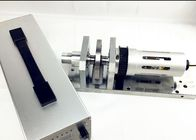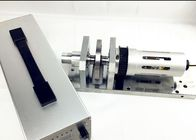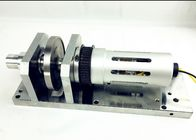
loading




| Quantity: | |
| Place of Origin | China |
|---|---|
| Brand Name | RPS-SONIC |
| Certification | CE |
| Model Number | RPS-S800 |
| Minimum Order Quantity | 1set |
| Price | negotiation |
| Packaging Details | FOAM AND CARTON |
| Delivery Time | 5days |
| Payment Terms | T/T, Western Union, MoneyGram, paypal |
| Supply Ability | 500 sets per month |
| Name | Ultrasonic Sewing Machine | Frequency | 35khz |
|---|---|---|---|
| Power | 800W | Horn Material | Rapid Steel,Titanium |
| Generator | Digital | ||
| High Light | ultrasonic seam welding equipment,ultrasonic sewing machine | ||
Ultrasonic bonding is the process of using high-frequency compression/relaxation of materials against specially designed anvil patterns that cause them to heat at the molecular level and melt.
Rotary horns are therefore typically made up of at least an axial input section and a radial weld section. The input section receives the axial acoustic energy, while the weld section applies the converted radial acoustic energy to the target parts. While the above-described conventional rotary horn is acceptable for some applications, certain important difficulties remain. One difficulty relates to the desire to obtain a high level of amplitude uniformity. Amplitude uniformity is effectively a measure of the percent of the weld receiving the same amount of weld energy. Specifically, amplitude uniformity is determined by measuring the maximum displacement of the external surface of the weld section (i.e., the weld “face”) for a given input excitation. The minimum displacement for the same excitation is also measured, and the ratio of the minimum displacement to the maximum displacement represents the amplitude uniformity. Thus, a rotary horn with an amplitude uniformity approaching one hundred percent would produce very uniform output acoustic energy over its entire weld face. High amplitude uniformity results in more predictable welds and ultimately lower manufacturing costs.
Some conventional rotary horns have an input section that is solid, and has a nodal point. Others have an input section that is hollow and has a nodal plane. All conventional rotary horns, convert axial acoustic energy into radial acoustic energy through the Poisson ratio effect and a number of top and bottom tuning cuts strategically machined out of the weld section. While the tuning cuts allow the conventional rotary horn to achieve acceptable uniformity levels (on the order of 85 percent or greater), this level of uniformity comes at a cost. Specifically, the machining of the tuning cuts is often quite complicated and requires additional tooling and labor.
It need be assembled on the ulltrasonic sewing machine, and drive by an other rotary horn.
Characteristics:
1. Seamming,trimming and embossing without glue, thread or other consumables
2. More faster and cost effective than traditional sewing machine and adhesive ways
3. Eliminates fraying or unraveling of bonded edges and seams
4. Multifunctional and thousands of designs available
5. Requires minimum training and maintenance
6. Super strong ultrasonic power meets the needs of different fabric thickness
RPS-SONIC specializes in manufacturing ultrasonic seam welding solutions for rotational systems.
Numerous seam soldering devices have been developed over the past years. From sonotrodes that can be installed in automated assembly lines, the Elmrt35 ultrasounds sewing machine up to customizations such as the PFW model devised for continuous welding of pleated filters.
There are two types of rotating modules for these operations: with either a side or central sonotrode resonating at a 35 kHz frequency and power varying from 400W to 1200W.
These horns can be made out of aluminium, treated with a special surface strengthening procedure, or titanium.
Our seam welding solutions are employed in binding synthetic textiles such as PVC, polyester, polypropylene, coated, filtering and technical fabrics.
| Item | Parameter |
| Frequency | 35KHZ |
| Power | 800W |
| Rotary horn diameter | 106MM |
| Amplitude | 28μm |
| Rotary horn material | Rapid steel,Titanium |
| Speed | 0.1-5m/s |
| Electrical tension: | 220 V single phase, 50 or 60 Hz |
| Welding width | 8mm |
Instead of needles, thread, glues or other adhesives, ultrasonic sewing equipment uses a patented rotary system, coupled with high-frequency vibrations, to bond synthetic or blended materials containing up to 40 percent natural fibers.
Resembling a traditional sewing machine, the ultrasonic sewing machine channels the ultrasonic vibrations between a horn and rotating wheel, producing a localized heat buildup which causes the synthetic fibers to soften and fuse. This creates a strong molecular bond that’s impervious to moisture. Explains Alleman, “the resulting barrier seams are sealed, secure, ultra-reliable and soft-to-the-touch without the safety issues caused by stitch holes, glue gaps, fraying or unraveling.”
| Name | Ultrasonic Sewing Machine | Frequency | 35khz |
|---|---|---|---|
| Power | 800W | Horn Material | Rapid Steel,Titanium |
| Generator | Digital | ||
| High Light | ultrasonic seam welding equipment,ultrasonic sewing machine | ||
Ultrasonic bonding is the process of using high-frequency compression/relaxation of materials against specially designed anvil patterns that cause them to heat at the molecular level and melt.
Rotary horns are therefore typically made up of at least an axial input section and a radial weld section. The input section receives the axial acoustic energy, while the weld section applies the converted radial acoustic energy to the target parts. While the above-described conventional rotary horn is acceptable for some applications, certain important difficulties remain. One difficulty relates to the desire to obtain a high level of amplitude uniformity. Amplitude uniformity is effectively a measure of the percent of the weld receiving the same amount of weld energy. Specifically, amplitude uniformity is determined by measuring the maximum displacement of the external surface of the weld section (i.e., the weld “face”) for a given input excitation. The minimum displacement for the same excitation is also measured, and the ratio of the minimum displacement to the maximum displacement represents the amplitude uniformity. Thus, a rotary horn with an amplitude uniformity approaching one hundred percent would produce very uniform output acoustic energy over its entire weld face. High amplitude uniformity results in more predictable welds and ultimately lower manufacturing costs.
Some conventional rotary horns have an input section that is solid, and has a nodal point. Others have an input section that is hollow and has a nodal plane. All conventional rotary horns, convert axial acoustic energy into radial acoustic energy through the Poisson ratio effect and a number of top and bottom tuning cuts strategically machined out of the weld section. While the tuning cuts allow the conventional rotary horn to achieve acceptable uniformity levels (on the order of 85 percent or greater), this level of uniformity comes at a cost. Specifically, the machining of the tuning cuts is often quite complicated and requires additional tooling and labor.
It need be assembled on the ulltrasonic sewing machine, and drive by an other rotary horn.
Characteristics:
1. Seamming,trimming and embossing without glue, thread or other consumables
2. More faster and cost effective than traditional sewing machine and adhesive ways
3. Eliminates fraying or unraveling of bonded edges and seams
4. Multifunctional and thousands of designs available
5. Requires minimum training and maintenance
6. Super strong ultrasonic power meets the needs of different fabric thickness
RPS-SONIC specializes in manufacturing ultrasonic seam welding solutions for rotational systems.
Numerous seam soldering devices have been developed over the past years. From sonotrodes that can be installed in automated assembly lines, the Elmrt35 ultrasounds sewing machine up to customizations such as the PFW model devised for continuous welding of pleated filters.
There are two types of rotating modules for these operations: with either a side or central sonotrode resonating at a 35 kHz frequency and power varying from 400W to 1200W.
These horns can be made out of aluminium, treated with a special surface strengthening procedure, or titanium.
Our seam welding solutions are employed in binding synthetic textiles such as PVC, polyester, polypropylene, coated, filtering and technical fabrics.
| Item | Parameter |
| Frequency | 35KHZ |
| Power | 800W |
| Rotary horn diameter | 106MM |
| Amplitude | 28μm |
| Rotary horn material | Rapid steel,Titanium |
| Speed | 0.1-5m/s |
| Electrical tension: | 220 V single phase, 50 or 60 Hz |
| Welding width | 8mm |
Instead of needles, thread, glues or other adhesives, ultrasonic sewing equipment uses a patented rotary system, coupled with high-frequency vibrations, to bond synthetic or blended materials containing up to 40 percent natural fibers.
Resembling a traditional sewing machine, the ultrasonic sewing machine channels the ultrasonic vibrations between a horn and rotating wheel, producing a localized heat buildup which causes the synthetic fibers to soften and fuse. This creates a strong molecular bond that’s impervious to moisture. Explains Alleman, “the resulting barrier seams are sealed, secure, ultra-reliable and soft-to-the-touch without the safety issues caused by stitch holes, glue gaps, fraying or unraveling.”








Ultrasonic Welding Equipment Ultrasonic Welding Transducer Ultrasonic Welding Converter Ultrasonic Liquid Processor Ultrasonic Cutting Equipment Ultrasonic Spray Nozzles Ultrasonic Power Supply Ultrasonic Soldering Equipment Ultrasonic Welding Horn Ultrasonic Assisted Machining Ultrasonic Testing Equipment
content is empty!